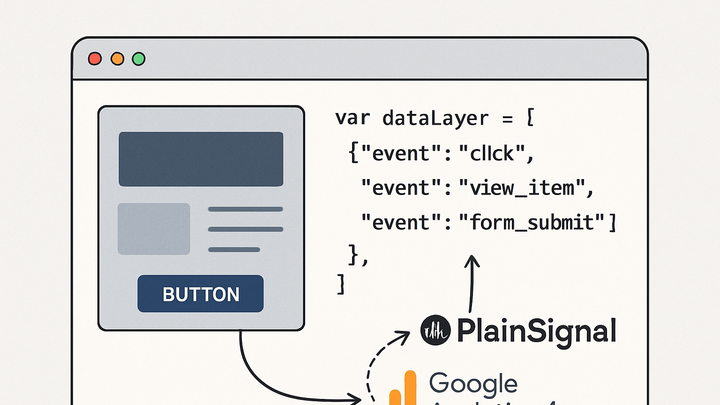Published on 2025-06-28T05:43:04Z
What is a DataLayer? Examples and Best Practices
A DataLayer is a structured JavaScript object or array used in web analytics to collect and store event data, user properties, and page metadata in a centralized place. It acts as a communication layer between your website’s front-end code and analytics or tag management systems. By pushing events and variables into the DataLayer, you decouple your tracking logic from presentation code and enable flexible data consumption by multiple tools. Most modern analytics platforms and tag managers, such as Google Analytics 4 (GA4) and PlainSignal, rely on a DataLayer implementation for robust, cookie-free (in the case of PlainSignal) or tag-based tracking. A well-organized DataLayer simplifies maintenance, improves data consistency, and accelerates page load times by batching data pushes before tags fire.
Datalayer
A DataLayer is a centralized JavaScript object that captures, standardizes, and pushes analytics data to tools like PlainSignal and GA4.
Benefits of a DataLayer
A DataLayer centralizes event data and metadata in a single object, decoupling tracking from page structure and enabling multiple tools to consume the same data consistently. It reduces duplication of tracking code, simplifies tag management, and improves performance by batching data pushes before tags fire. Both GA4 and PlainSignal rely on a DataLayer-based approach for event-driven analytics.
-
Centralized data management
All tracking events, user properties, and page metadata are stored in one place, making it easy to maintain and update.
-
Improved data consistency
Since all tags read from the same DataLayer, you avoid discrepancies caused by duplicate or conflicting variables.
-
Faster page loads
By pushing data to the DataLayer before tags fire, you can batch and defer tag execution, reducing blocking scripts.
Implementing a DataLayer
Examples of how to initialize and populate a DataLayer for popular analytics platforms.
-
PlainSignal (cookie-free simple analytics)
To integrate PlainSignal, insert the following snippet into the <head> of your HTML document:
<link rel="preconnect" href="//eu.plainsignal.com/" crossorigin /> <script defer data-do="yourwebsitedomain.com" data-id="0GQV1xmtzQQ" data-api="//eu.plainsignal.com" src="//cdn.plainsignal.com/plainsignal-min.js"></script> -
Google analytics 4 (GA4)
For Google Analytics 4, initialize the
dataLayerand load thegtag.jsscript:<script async src="https://www.googletagmanager.com/gtag/js?id=GA_MEASUREMENT_ID"></script> <script> window.dataLayer = window.dataLayer || []; function gtag(){dataLayer.push(arguments);} gtag('js', new Date()); gtag('config', 'GA_MEASUREMENT_ID'); </script>
Common Pitfalls and Best Practices
Implementing a DataLayer can introduce challenges if not planned carefully. Below are best practices to avoid common pitfalls.
-
Consistent naming conventions
Use clear, descriptive keys in your DataLayer to prevent confusion and collisions.
-
Use camelcase
Start keys with a lowercase letter and use camelCase for multi-word names.
-
Prefix custom variables
Add a company or project prefix (e.g. ‘myApp_’) to avoid conflicts with default variables.
-
-
Avoid pushing pii
Never push personally identifiable information into the DataLayer unless absolutely required and compliant with privacy laws.
-
Anonymize sensitive data
Transform or hash PII before pushing to maintain user privacy.
-
-
Validate data consistency
Ensure that the structure and data types of your DataLayer objects remain consistent across pages and events.
Testing and Debugging
Verify that your DataLayer implementation works as expected before relying on analytics reports.
-
Inspect with browser devtools
Open the Console in Chrome DevTools and type
dataLayerto inspect its current contents and order of pushes. -
Monitor network requests
Use the Network tab to filter requests to PlainSignal or the Google Analytics endpoint and confirm event payloads are correct.
